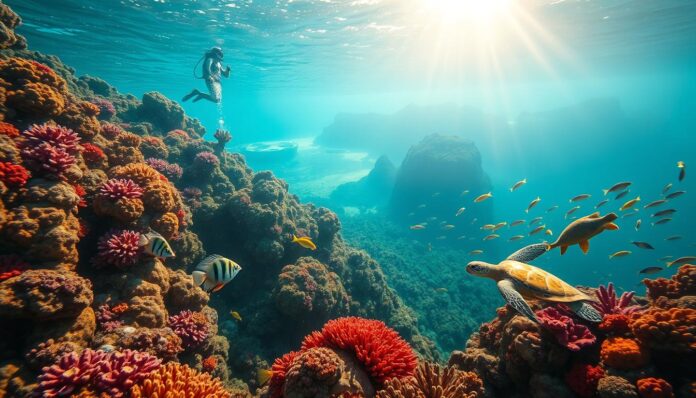Are you ready to explore Central America’s underwater paradise? Imagine diving into a world where the Mesoamerican Barrier Reef stretches from Mexico to Honduras. It offers some of the most breathtaking scuba diving experiences on Earth.
Central America’s dive destinations offer an unparalleled underwater adventure. They combine diverse marine ecosystems, incredible biodiversity, and affordable diving experiences. From the Pacific to the Caribbean, this region boasts a remarkable underwater landscape that attracts divers from around the globe.
The Mesoamerican Barrier Reef, the second-largest barrier reef worldwide, provides divers with an extraordinary playground. Locations like Cozumel in Mexico offer excellent visibility and strong currents perfect for drift diving. Destinations such as Utila in Honduras provide budget-friendly opportunities to explore underwater wonders.
Key Takeaways – Scuba Diving in Central America
- Central America offers diverse and affordable scuba diving experiences
- The Mesoamerican Barrier Reef provides world-class underwater exploration
- Dive sites range from shallow reef environments to deep marine ecosystems
- Multiple destinations offer unique marine life encounters
- Costs for diving and certification are relatively affordable in the region
- Both Pacific and Caribbean coasts provide exceptional diving opportunities
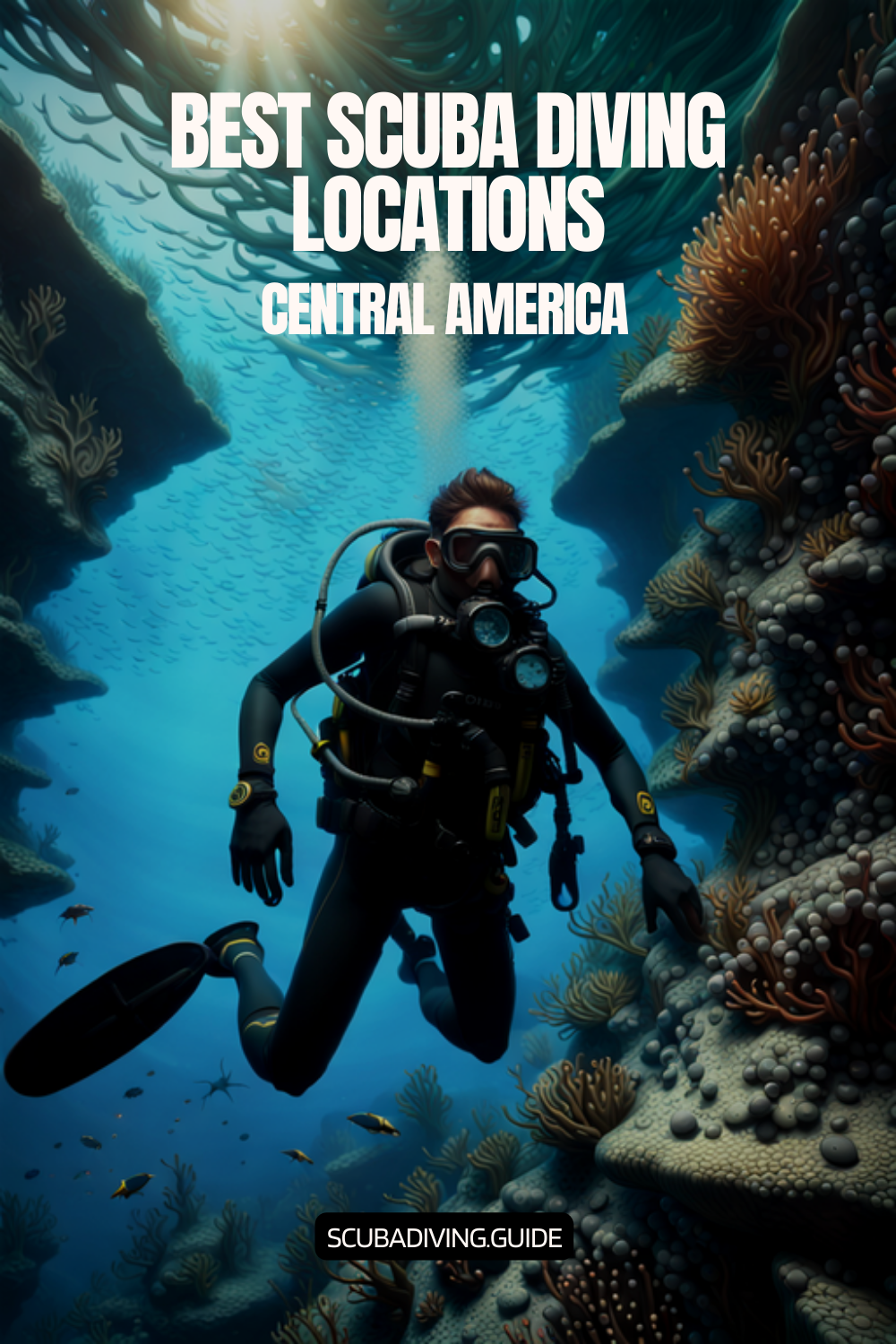
What to Expect When Scuba Diving in Central America
Central America is a paradise for scuba diving, attracting enthusiasts from everywhere. Its marine life is incredibly diverse, providing unique experiences for divers. These adventures are unlike anything you’ve seen before.
Exploring coral reefs here is like stepping into a colorful, mysterious world. The Mesoamerican Reef stretches almost 700 miles. It’s a place where life thrives, giving divers a chance to see it all up close.
Unique Marine Life Encounters
Central America’s waters are home to incredible wildlife. Here’s what you might see:
- Whale sharks gliding quietly in clear waters
- Sea turtles swimming alongside you
- Tropical fish creating colorful rainbows
- Rare manta rays with wings up to 30 feet wide
“The underwater world of Central America is not just a dive, it’s an immersion into nature’s most spectacular realm.”
Diverse Underwater Ecosystems
The dive sites in Central America are incredibly diverse. You’ll find:
- Vibrant coral reefs with over 700 patch reef systems
- Underwater caves with unique formations
- Marine reserves protecting delicate ecosystems
- Open ocean areas with amazing visibility
From UNESCO World Heritage Sites like Glover’s Atoll to incredible marine reserves, Central America offers unforgettable dives. These experiences will leave you with memories that last forever.
Top Destinations for Scuba Diving
Central America is home to some of the most amazing underwater sights for divers. You can explore everything from mysterious marine sinkholes to colorful coral reefs. These underwater adventures draw divers from all over the world.
Belize: The Great Blue Hole
The Belize Barrier Reef is home to the famous Great Blue Hole. This huge sinkhole is 1000 feet wide and almost 500 feet deep. Jacques Cousteau made it famous, and it’s a must-see dive site with its unique underwater features.
- Depth: 400 feet
- Location: Lighthouse Reef
- Unique feature: Stalactite-studded underwater caves
Honduras: Utila Island
Utila Dive Resorts offer great diving at affordable prices. It’s part of the Bay Islands and next to the world’s second-largest barrier reef. Divers can see incredible marine life, including whale sharks during certain seasons.
| Diving Attribute | Details |
|---|---|
| Certification Cost | Approximately $229 |
| Marine Life | Whale Sharks, Diverse Reef Species |
| Water Conditions | Calm, Excellent for Training |
Costa Rica: Cocos Island
For those who dive in Roatan, Cocos Island is a must-see. It’s a UNESCO World Heritage Site, 300 miles off the coast. The journey takes a day and a half by boat, but the encounters with pelagic species are unforgettable.
“Cocos Island offers the highest concentrations of hammerhead sharks worldwide” – Marine Exploration Magazine
- Distance from Mainland: 300 miles
- Boat Travel Time: 36 hours
- Unique Wildlife: Hammerhead Sharks, Marlin, Sailfish
Planning Your Scuba Diving Trip
Getting ready for a scuba diving trip in Central America needs careful planning. Scuba Diving in Central America offers unique experiences. You need to prepare well to enjoy your underwater adventure fully.
Planning a trip to Central America’s dive spots is key. You need to think about timing, equipment, and local dive operators. This can turn a simple trip into an amazing underwater journey.
Best Time to Dive in Central America
Diving conditions change a lot in Central America. You should think about the season and when marine life moves. Here are some tips:
- Dry Season (December-April): Best for clear waters and calm dives
- Rainy Season (May-November): Great for shark sightings
- Whale migration periods: January and March for marine mammal sightings
Essential Gear and Equipment
Having the right gear is important for a safe and fun dive. Here are some tips:
| Equipment | Rental Options | Personal Recommendation |
|---|---|---|
| Wetsuit | Available locally | Bring your own for comfort |
| Mask/Snorkel | Limited availability | Bring your own for best fit |
| Diving Computer | Some operators provide | Use your own for safety |
How to Choose a Dive Operator
Picking the right dive operator is important. Look for these things:
- Certified guides
- Good safety protocols
- Small group sizes
- Commitment to the environment
“A great dive operator makes your trip unforgettable” – Professional Diving Instructor
Pro Tip: Book your dive trip early in peak seasons. This ensures you get the best experience.
Plan your trip 3-6 months in advance. This helps with smooth logistics and better diving experiences.
Safety Tips for Scuba Divers
Scuba Diving in Central America needs careful safety steps for a fun and safe dive. Knowing local rules and caring for the sea are key to diving right.
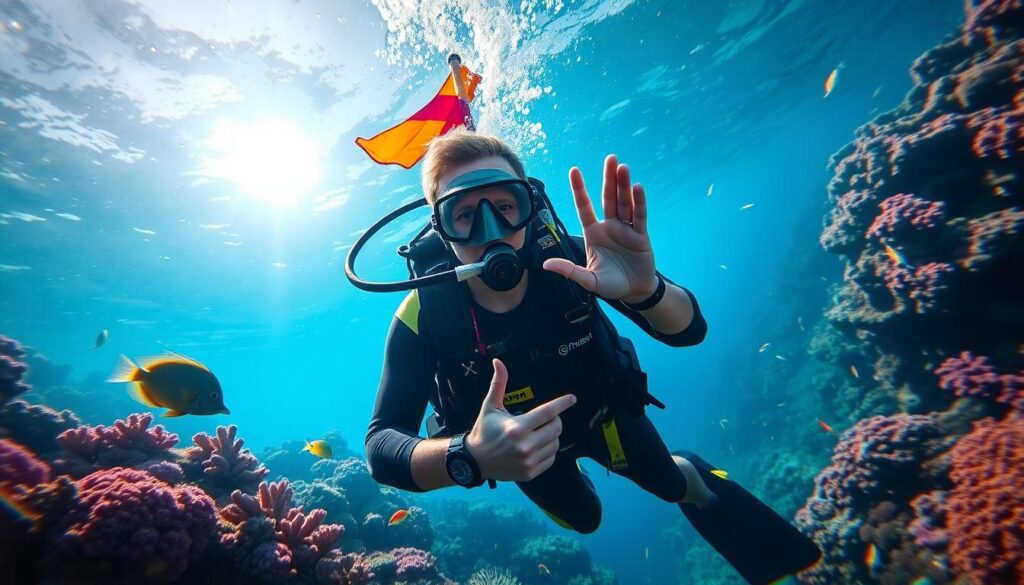
Scuba diving safety is about many important things. These things can greatly affect your dive. Knowing how to prepare and stay alert is vital for safe Coral Reef Exploration.
Critical Safety Protocols
- Always dive with a certified buddy
- Check equipment before each dive
- Understand personal physical limitations
- Maintain proper communication with dive partners
Understanding Local Diving Regulations
Diving rules vary across Central America. About 40% of dive operators need to see your certification. It’s important to know the rules before you go.
| Safety Consideration | Recommended Action |
|---|---|
| Medical Examination | Required before diving (15% of new divers found unfit) |
| Insurance Coverage | Verify diving-specific coverage (45% of travelers overlook this) |
| Depth Limitations | Maximum recreational depth: 40m (130ft) |
Environmental Protection Practices
Responsible divers in Central America focus on protecting the sea.
“Protect what you explore” is more than a motto—it’s a diving commitment.
- Avoid touching coral formations
- Do not disturb marine life
- Minimize underwater waste
- Follow designated marine park guidelines
By following these safety tips, divers can greatly lower risks. About 70% of diving accidents could be avoided with the right training and safety steps.
Scuba Diving Certifications
Exploring Central America’s underwater world needs proper training and certification. Scuba diving here offers great chances for all divers to learn more about the sea.
Diving certifications unlock amazing underwater adventures. Whether you’re new or have lots of experience, Central America has many ways to boost your skills.
Recognized Certification Agencies
Many well-known dive certification agencies work in Central America:
- PADI (Professional Association of Diving Instructors)
- SSI (Scuba Schools International)
- NAUI (National Association of Underwater Instructors)
- SDI (Scuba Diving International)
Popular Certification Courses
Divers can pick from different certification levels in Central America:
- Open Water Diver Course
- Duration: 4 days
- Cost: $575 US
- Includes 5 confined water and 4 open water dives
- Advanced Open Water Certification
- Duration: 2+ days
- Cost: $475 US
- Includes 5 total dives (3 elective, 2 core)
“Getting certified in Central America not only improves your diving skills but also allows you to explore some of the most spectacular underwater ecosystems in the world.”
When planning your scuba diving certification in Central America, think about the cost, how long it takes, and the marine environments you’ll see. Many dive centers offer full packages that mix learning with unforgettable dives.
Underwater Photography Tips
Capturing the vibrant marine world of Central American Dive Destinations requires skill, patience, and the right equipment. Coral Reef Exploration offers photographers a breathtaking canvas of underwater beauty. It has unique challenges and incredible opportunities for stunning imagery.
Underwater photography demands specialized techniques and gear. It faces unique challenges in marine environments. Light, color, and movement create complex conditions that require precise technical knowledge.
Best Techniques for Capturing Marine Life
- Maintain an ideal distance of 12 inches from marine subjects
- Use recommended shutter speeds:
- 1/30th for stationary subjects
- 1/60th for slow-moving creatures
- 1/125th for fast marine life
- Shoot in depths of 20 feet or less for natural lighting
- Practice vertical compositions 50% of the time
Recommended Gear for Underwater Photography
| Camera Model | Recommended Lens | ISO Range |
|---|---|---|
| Nikon D700 | 17-35mm f/2.8 AF-S | 400-800 |
| Nikon D300 | 10-24mm f/3.4-4.5G | 400-800 |
“The magic of underwater photography lies not just in technical perfection, but in capturing the raw, untamed beauty of marine ecosystems.”
Post-processing is key in underwater photography. Adobe Photoshop helps enhance RAW files, bringing out the details of Central American marine life. Remember to increase saturation sparingly—no more than 5-10%—to maintain natural colors.
Pro tip: Always check your camera settings before each dive. Manual white balance adjustment every 5-10 feet can prevent those dreaded blue-tinted photographs that plague underwater photography beginners.
Diving Conditions in Central America
Scuba diving in Central America is a unique underwater adventure. You’ll find diverse marine environments and special diving conditions. From the clear waters of the Belize Barrier Reef to the strong currents of coastal areas, there’s something for everyone.
Water Temperature and Visibility
Central America’s diving spots are known for their great water conditions. The water temperature is usually between 75-85°F. This makes diving comfortable all year round.
- Pacific Coast: Average water temperature around 80°F
- Caribbean Side: Slightly warmer waters, often 82-84°F
- Visibility ranges from 50-100 feet, depending on location
Currents and Weather Patterns
Diving conditions in Central America change a lot depending on where you are. For example, Cozumel is famous for its clear waters and strong currents. It’s perfect for drift diving.
| Location | Current Strength | Best Diving Season |
|---|---|---|
| Belize Barrier Reef | Moderate | March-June |
| Honduras (Roatan) | Light to Moderate | April-September |
| Costa Rica (Caño Island) | Variable | August-December |
Pro tip for Scuba Diving in Central America: Always check local dive conditions and consult experienced local operators before planning your underwater adventure.
“The ocean’s diversity in Central America offers something for every diver, from calm protected bays to challenging drift diving experiences.” – Marine Exploration Journal
Accommodation Options Near Dive Sites
Central America has many places to stay for scuba lovers. You can find luxury or budget-friendly spots. There’s something for every diver’s taste and budget.
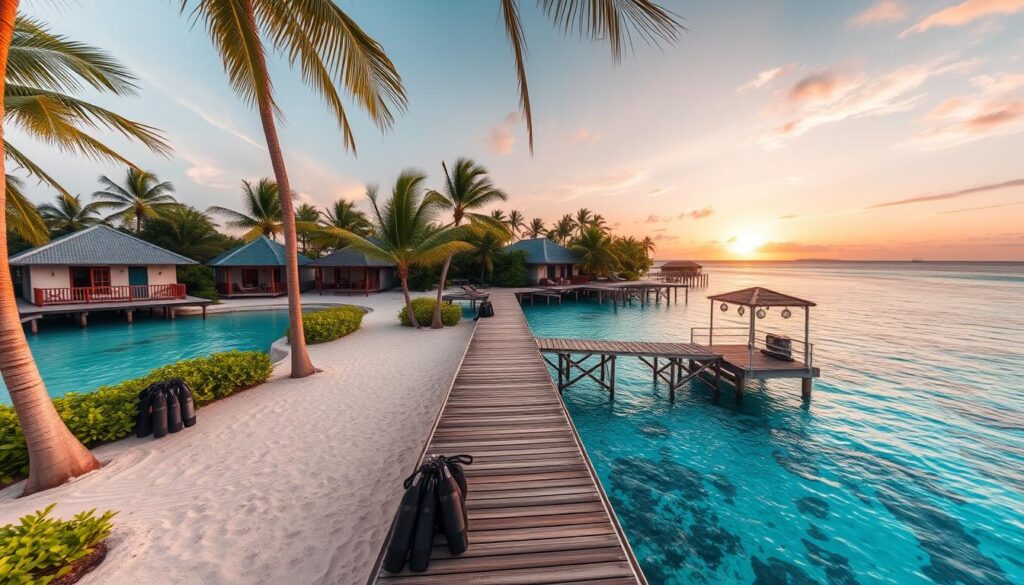
Best Resorts for Divers
Utila Dive Resorts are top picks for divers. They offer special features that make diving better.
- Gear storage facilities
- Rinse tanks for equipment
- Direct access to dive sites
- Professional dive shop on-site
Budget-Friendly Dive Stays
There are cheap places to stay near great diving spots. Divers on a budget can explore Central America’s seas without spending too much.
| Location | Average Price | Diver Amenities |
|---|---|---|
| Bosque del Mar Hotel | $90-$150/night | 3-star, 27 rooms, near dive sites |
| Rocket Frog Divers Resort | $70-$120/night | PADI 5 Star, 5 dive boats, multilingual guides |
“Finding the right accommodation can make or break your diving adventure in Central America.” – Professional Dive Instructor
Think about how close it is to dive sites, where to store your gear, and the dive shop’s reputation. Utila Dive Resorts usually offer the best diving-focused stays.
Other Activities for Divers
Central America has more than amazing underwater sights for divers. While diving in Costa Rica and Guatemala is top-notch, there’s a lot more to do. You can explore the region’s diverse landscapes and cultures.
Diving travelers can dive into more than just the ocean. The area’s rich wildlife offers endless chances to explore. It’s a perfect place for those who love adventure and nature.
Snorkeling Opportunities
Snorkeling is a great choice for those who prefer lighter water activities. The coastlines of Central America have stunning snorkeling spots. You’ll find clear waters and colorful marine life.
- Shallow reef systems perfect for beginners
- Opportunities to observe colorful tropical fish
- Accessible marine environments near popular diving locations
Eco-Tours and Wildlife Watching
Central America’s wildlife makes diving trips even more special. You can see amazing animals and landscapes. It’s a chance to learn about the region’s incredible biodiversity.
| Location | Wildlife Highlights | Best Viewing Season |
|---|---|---|
| Costa Rica | Tropical birds, sloths, monkeys | December-April |
| Guatemala | Quetzal birds, volcanic landscapes | November-April |
| Panama | Exotic reptiles, rainforest mammals | January-April |
“Central America isn’t just about underwater adventures—it’s a complete ecosystem waiting to be explored!” – Nature Expedition Magazine
There’s more to do than just dive. You can visit ancient Mayan ruins, explore national parks, and support sustainable tourism. These activities turn a diving trip into a full Central American adventure.
Encountering Marine Conservation Efforts
Scuba diving in Central America is more than just fun. It’s a chance to help protect the world’s most delicate marine ecosystems. Coral Reef Exploration is about seeing marine life and learning to save our oceans.
Divers can help save marine habitats through conservation programs. These efforts keep our oceans healthy and provide important data on marine life.
Dive Programs for Conservation
There are many conservation programs for divers to join. They focus on:
- Coral restoration projects
- Marine life population surveys
- Invasive species management
- Sea turtle monitoring
Supporting Local Marine Protected Areas
Central America has many marine protected areas. These places are vital for our planet’s health. Scuba diving here supports these areas by promoting responsible tourism and direct involvement.
“Take nothing but memories, leave nothing but bubbles” – A guiding principle for responsible marine conservation
| Conservation Program | Location | Focus Area |
|---|---|---|
| Sea Turtle Ecology | Las Baulas National Park | Turtle Population Monitoring |
| Shark Ecology | Bats Islands | Shark Population Research |
| Coral Nursery | Various Marine Reserves | Reef Restoration |
Joining these programs lets divers make a real difference. They get to enjoy the ocean while helping protect it.
Diving for Beginners
Scuba Diving in Central America is a great chance for newbies to see underwater wonders. The area offers special experiences for diving fans, perfect for those starting out.
Introductory Courses and Experiences
Central America’s dive spots welcome beginners with special programs. These programs help build confidence and skills. Many dive centers offer Discover Scuba Diving experiences for new divers to safely explore the sea.
- Basic introductory courses usually last 1-2 days
- Professional instructors give hands-on training
- Classes include classroom lessons and supervised water sessions
“Learning to dive is like opening a door to an entirely new world of adventure!” – Professional Dive Instructor
Common Mistakes to Avoid
New divers in Central America should watch out for common mistakes. This ensures a safe and fun dive.
| Common Mistake | Prevention Strategy |
|---|---|
| Rushing Equipment Setup | Take time to carefully check all gear |
| Holding Breath Underwater | Practice steady, continuous breathing |
| Overexerting Yourself | Know your physical limits |
Costa Rica is perfect for beginners with its diverse marine life. The warm waters are home to a wide variety of sea creatures. This makes each dive a unique learning experience. Beginner dive sites around places like the Catalina Islands have gentle currents and shallow depths, ideal for new divers.
- Start with guided introductory dives
- Choose locations with calm waters
- Always dive with a certified instructor
- Prioritize safety and proper training
With the right preparation and guidance, scuba diving in Central America can be a memorable adventure for beginners eager to explore underwater worlds.
Local Cuisine to Try After Diving
Scuba diving in Central America is more than just underwater fun. After diving, you can enjoy amazing local foods. These dishes show off the region’s rich food culture.
Traditional Dishes of Central America
Central American food is as diverse as the diving spots. Each country has its own flavors that will make your taste buds dance:
- Costa Rica: Gallo Pinto, a mix of rice and beans for breakfast
- Honduras: Baleadas, a wheat tortilla with beans, cheese, and cream
- Belize: Seafood like conch fritters and lobster
- Nicaragua: Vigorón, a dish with yuca, chicharrón, and cabbage salad
Best Local Restaurants for Divers
After diving, these local spots offer real food experiences:
| Country | Restaurant | Specialty Dish |
|---|---|---|
| Costa Rica | Restaurante Típico | Casado (traditional mixed plate) |
| Honduras | Xatrucho | Pastelitos and Carne Guisada |
| Belize | Coastal Kitchen | Fresh seafood platters |
“Food is our common ground, a universal experience.” – James Beard
Trying local food is key to diving in Central America. Each dish shares a story of culture, local ingredients, and traditions passed down through generations.
Traveler Tips: What to Bring Along
Getting ready for your Scuba Diving in Central America trip needs careful planning. The climate is hot and humid, so pack light and practical. Choose 14 versatile clothes that keep you cool in 28-35°C temperatures.
When planning your trip, don’t forget important documents and money matters. Make sure your passport is good for at least 6 months. Carry both credit and debit cards for easy spending. Travel insurance is key, with some cards covering diving. Also, budget for National Marine Park fees, which are about $5 USD a day.
Must-Have Items for Diving Trips
Use a lightweight dive bag like the Cressi Moby 5 for lots of space. It has 115 liters of room. Don’t forget a first aid kit with Tiger Balm and charcoal tablets.
Bring two towels, one for saltwater and one for freshwater. A spare parts kit with O-rings, mask straps, and tie wraps is also a good idea. Reef-friendly sunscreen, a personal mask, and snorkel can make your dive better.
Essential Travel Documents and Insurance
Bring small toiletry samples to save space and weight. Drink water often, even with alcohol. Use biodegradable conditioner to protect your hair from salt.
With the right preparation, your Scuba Diving in Central America trip will be amazing and unforgettable.
Central America Recommended Scuba Diving Itinerary
Central America offers a plethora of extraordinary scuba diving destinations, making it a dream come true for diving enthusiasts. To make the most of your scuba diving adventure in the region, consider following this recommended itinerary that highlights some of the top dive sites and experiences Central America has to offer:
Day 1: Arrival in Belize
Arrive in Belize, a country renowned for its stunning barrier reef system and the famous Great Blue Hole. After settling into your accommodation, spend the day exploring the local area and preparing for the thrilling dives that await you.
Day 2-4: Ambergris Caye and Hol Chan Marine Reserve
Head to Ambergris Caye, a vibrant island with easy access to the Hol Chan Marine Reserve. Dive into the crystal-clear waters and explore the reserve’s rich marine life, including nurse sharks, stingrays, and colorful reef fish. Don’t miss the opportunity to dive the renowned Shark Ray Alley, where you can encounter friendly nurse sharks and southern stingrays up close.
Day 5-7: Turneffe Atoll and Blue Hole
Embark on a liveaboard or join a dive excursion to the Turneffe Atoll and the world-famous Blue Hole. Dive the walls of the atoll, adorned with beautiful coral formations and teeming with marine life. Descend into the depths of the Blue Hole, an awe-inspiring sinkhole that offers a unique and captivating underwater experience.
Day 8-10: Roatan, Honduras
Fly to Roatan, one of the Bay Islands in Honduras. Dive along the vibrant coral reefs of the Roatan Marine Park, where you can encounter sea turtles, eagle rays, and a myriad of tropical fish species. Explore stunning wall dives, swim-throughs, and the chance to spot whale sharks during certain times of the year.
Day 11-12: Utila, Honduras
Take a short boat ride to Utila, another gem in the Bay Islands of Honduras. Dive the impressive underwater topography, including swim-throughs, caves, and seamounts. Utila is known for its affordable diving courses, so if you’re looking to obtain certifications or advance your skills, this is the perfect place to do it.
Day 13-15: Manuel Antonio National Park, Costa Rica
Fly to Costa Rica and make your way to Manuel Antonio National Park. Enjoy a combination of jungle adventures and diving excursions. Dive the offshore islands, where you can witness an abundance of marine life, including colorful nudibranchs, eels, and schools of tropical fish. Take time to explore the rainforest, spot wildlife, and relax on the pristine beaches.
Day 16-18: Coiba National Park, Panama
Travel to Panama and venture to Coiba National Park, a UNESCO World Heritage Site. Join a liveaboard or take a boat ride to this remote and pristine area. Dive the protected marine park, known for its vibrant coral reefs, abundant marine life, and encounters with large pelagic species such as sharks, rays, and humpback whales during migration season.
Day 19-20: Pearl Islands, Panama
Continue your journey to the Pearl Islands archipelago. Dive the untouched coral reefs, swim through vibrant coral gardens, and encounter a variety of marine species. These remote islands offer a tranquil and exclusive diving experience, with pristine waters and breathtaking landscapes.
Day 21: Departure
Bid farewell to Central America, taking with you memories of unforgettable diving adventures. Depart from the nearest international airport, reflecting on the incredible underwater wonders you discovered during your scuba diving journey.
Note: This itinerary provides a general outline and can be customized based on your preferences, time constraints, and budget. It’s important to consider factors such as travel logistics, weather conditions, and the availability of accommodations and dive services when planning your scuba diving itinerary in Central America.
By following this recommended scuba diving itinerary, you can explore the best dive sites and experiences that Central America has to offer. Each destination will provide you with unique underwater landscapes, encounters with diverse marine life, and the thrill of exploring some of the world’s most renowned dive sites. Get ready to create lifelong memories and embark on a scuba diving adventure of a lifetime in Central America!
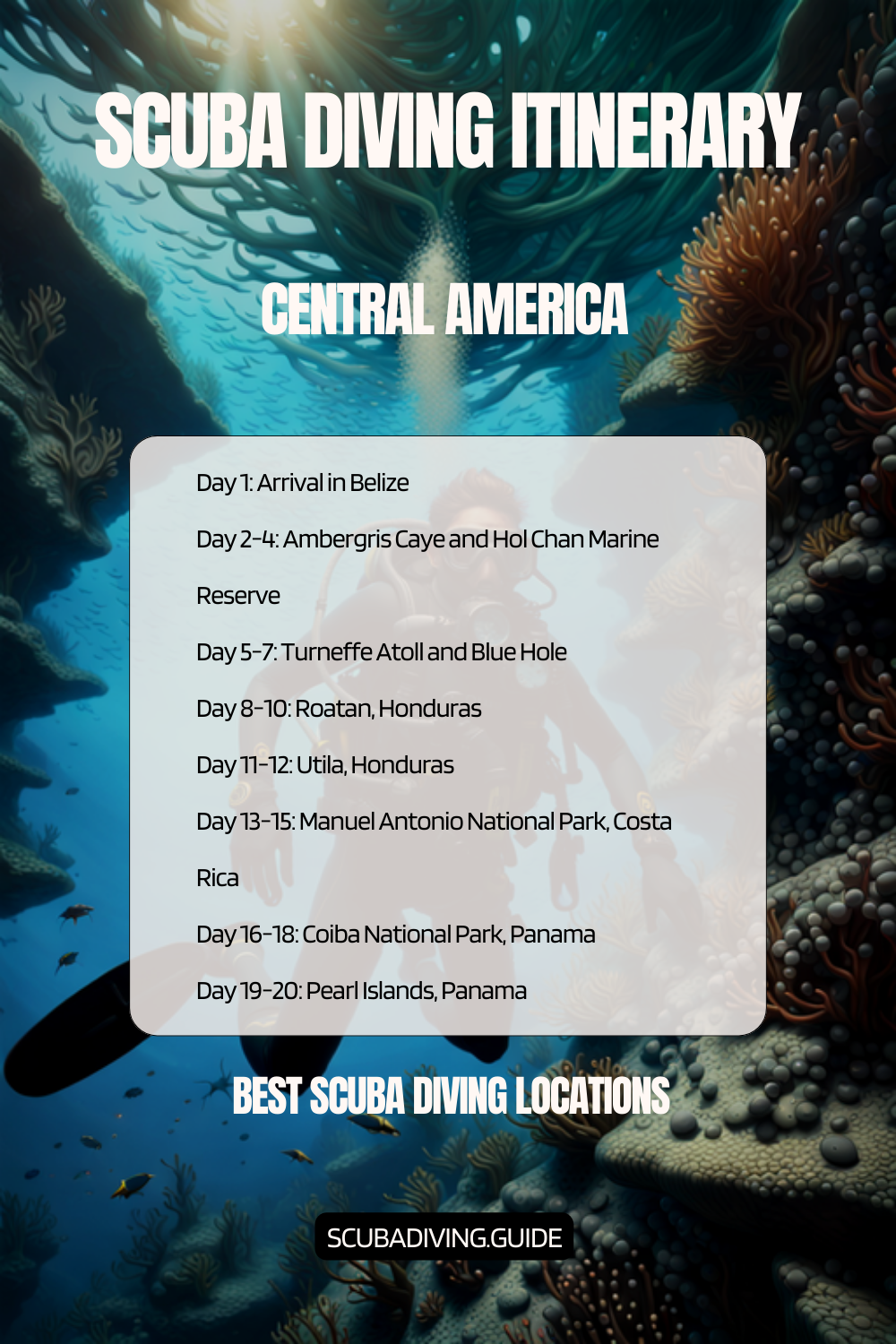
Countries to Consider
- Belize
- Costa Rica
- Guatemala
- Honduras
- Mexico
- Nicaragua
- Panama
FAQ – Scuba Diving in Central America
What are the best diving destinations in Central America?
Central America is a paradise for divers. The Great Blue Hole in Belize is a must-see. In Honduras, Utila Island is famous for whale shark sightings. Roatan boasts stunning reefs.
Cocos Island in Costa Rica is perfect for advanced divers. The Caribbean and Pacific coasts of many countries are also great for exploring diverse marine life.
When is the best time to go scuba diving in Central America?
The best diving time varies by location. The dry season, from December to April, usually has clear waters. For whale sharks in Utila, the best months are March to April and August to September.
Always check the local conditions before you go.
Do I need a specific certification to dive in Central America?
Most dive operators need an Open Water certification. Beginners can start with Discover Scuba programs. Many places offer certification courses on-site.
For advanced sites like Cocos Island, you’ll need more experience and certifications.
What marine life can I expect to see while diving?
Central America is home to a wide variety of marine life. You might see whale sharks, sea turtles, and colorful fish. Manta rays and vibrant coral reefs are also common.
Places like Cozumel and the Belize Barrier Reef are known for their rich marine life.
Is scuba diving in Central America safe for beginners?
Yes, many places in Central America are great for beginners. Utila and parts of Belize have calm waters and professional schools. Always choose reputable operators and follow safety rules.
Some sites, like Cocos Island, are better for experienced divers.
What equipment should I bring for diving in Central America?
Bring personal items like a mask, dive computer, and wetsuit. A 3mm wetsuit is usually enough for tropical waters. Check with your dive operator about their policies and rental options.
How expensive is scuba diving in Central America?
Diving costs vary, but Central America is generally affordable. Budget-friendly places like Utila offer dives for $30-$50. More exclusive spots like Cocos Island can be pricier.
Look for dive packages and stay at dive resorts to save money.
Are there conservation opportunities for divers?
Yes! Many places in Central America have marine conservation programs. Divers can help with coral restoration and marine life surveys. Countries like Belize and Costa Rica are active in conservation and welcome responsible divers.
